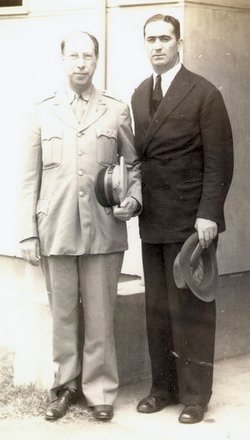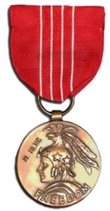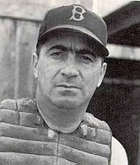Moe Berg
Ballplayers Decorated in World War II
| Date and Place of Birth: | March 2, 1902 New York, NY |
| Date and Place of Death: | May 29, 1972 Newark, NJ |
| Baseball Experience: | Major League |
| Position: | Catcher |
| Rank: | |
| Military Unit: | Office of Strategic Services |
| Area Served: | Europe and South America |
"Professor" Moe Berg, one-time big league baseball catcher, is
going to Latin-America as an extraordinary good-will ambassador. His
diplomatic mission, is almost without parallel in the annals of
diplomacy.
Associated Press August 13, 1942
Morris “Moe” Berg was born in New York city on March 2, 1902, the third
and last child of Bernard Berg, a pharmacist, and Rose Tashker. Berg
first began playing baseball for the Roseville Methodist Episcopal
Church baseball team. In 1918, at the age of 16, he graduated from
Barringer High School and during his senior year, the Newark Star-Eagle
selected a nine-man "dream team" with Berg named as third baseman.
After graduating from Barringer, Berg enrolled in New York University.
He spent two semesters there and played baseball and basketball. In
1919, he transferred to Princeton University. Berg played first base on
the undefeated Princeton team during his freshman year. The following
season he was the starting shortstop. Berg was team captain his senior
season and had a .337 batting average.
On June 26, 1923, Yale defeated Princeton, 5-1, at Yankee Stadium, to
win the Big Three title. Berg had an outstanding day, getting two hits
in four at-bats with a single and a double, and making several superb
plays at shortstop. Both the New York Giants and the Brooklyn Dodgers
were keen to sign the youngster.
Berg graduated with a degree in modern languages having studied Latin,
Greek, French, Spanish, Italian, German and Sanskrit. This was to later
inspire the observation by Chicago White Sox teammate, Ted Lyons, that
"he can speak twelve languages but can't hit in any of them."
On June 27, 1923, he signed with the Dodgers for $5,000. He played 49
games with Brooklyn that year and batted just .186. At the end of the
season, Berg sailed to Paris, France, where he enrolled at the Sorbonne.
Then in January 1924, he toured Italy and Switzerland.
He was optioned by Brooklyn to the Minneapolis Millers of the Class AA
American Association for 1924, and was loaned to the Toledo Mud Hens of
the same league in August and finished the season with a .264 average.
Berg spent 1926 with the Reading Keystones of the Class AA International
League and was selected off waivers by the Chicago White Sox at the end
of the season.
Berg spent the next five seasons with the White Sox and converted to a
catcher in 1927. The Indians purchased Berg in April 1931, but he played
just ten games and was released at the end of the season. The Senators
picked him up for 1932 and he played 75 games, hitting .236.
During the winter of 1932, Berg, along with Lefty O'Doul, and Ted Lyons,
went to teach baseball seminars at Japanese universities. When the other
Americans returned to the United States after their coaching assignments
were over, Berg stayed behind to explore Japan. He went on to tour
Manchuria, Shanghai, Peking, Indochina, Siam, India, Egypt and Berlin.
He returned to Japan in 1934, as part of an all-star group of players,
including Babe Ruth, Lou Gehrig, Earl Averill, Charlie Gehringer, Jimmie
Foxx and Lefty Gomez. Despite Berg being a mediocre, third-string
catcher, he was invited at the last minute to make the trip. He had with
him a 16-mm movie camera and gave a welcome speech in Japanese upon the
all-stars’ arrival.
On November 29, 1934, while the rest of the team was playing in Omiya,
Berg went to Saint Luke's Hospital in Tsukiji (a district of Tokyo).
Berg went up on the roof of the hospital - one of the tallest buildings
in Tokyo - and filmed the city and harbor with his movie camera.
Berg had been released by the Indians while he was in Japan. After his
return to the United States, he was picked up by the Boston Red Sox. In
his five seasons with the Red Sox, Berg averaged fewer than 30 games a
season. After retiring as a player, he spent one year as the team’s
bullpen coach in 1940.
Following the Japanese attack on Pearl Harbor in December 1941, Berg
accepted a position with the Office of Inter-American Affairs (OIAA) on
January 5, 1942. During the summer of that year, he screened the footage
he shot of Tokyo Bay for military intelligence officers. From August
1942 until February 1943, Berg was on assignment in the Caribbean and
South America. His job was to monitor the health and physical fitness of
the American troops stationed there. Berg, along with several other OIAA
agents, left in June 1943, because they thought South America posed
little threat to the United States, and they wanted to be where their
talents would be put to better use.
On August 2, 1943, Berg accepted a position with the Office of Strategic
Services (OSS). In September, he was assigned to the Secret Intelligence
branch of the OSS and given a place at the OSS Balkans desk. In this
role, he parachuted into Yugoslavia to evaluate the various resistance
groups operating against the Nazis to determine which was the strongest.
His evaluations were used to help determine the amount of support and
aid to give each group.
In late 1943, Berg was assigned to Project Larson, an OSS operation set
up by OSS Chief of Special Projects John Shaheen. The stated purpose of
the project was to kidnap Italian rocket and missile specialists out of
Italy and bring them to the United States. However, there was another
project hidden within Larson called Project AZUSA with the goal of
interviewing Italian physicists to see what they knew about Werner
Heisenberg and Carl Friedrich von Weizsäcker. It was similar in scope
and mission to the Alsos project (an organized effort by a team of
United States military, scientific, and intelligence personnel to
discover enemy scientific developments, with its chief focus was on the
German nuclear energy project). On May 4, 1944, Berg left for London and
the start of his mission.
From May to mid-December, Berg hopped around Europe interviewing
physicists and trying to convince several of them to work in America.
Despite Berg's wartime vocation calling for anonymity, he did betray
himself on one occasion. While at a field hospital in France, Berg could
not resist the temptation to join in a game of catch with a couple of
GIs. After the former major leaguer had made a couple of throws one of
the soldiers remarked, "You're a pro." Soon afterwards the soldier
added, "You're a catcher," another throw and his cover was blown, "and
your name is Moe Berg."
At the beginning of December, Berg attended a lecture by prominent
German physicist Werner Heisenberg in Zurich, Switzerland. Posing as a
Swiss graduate student, he carried in his pocket a pistol and a cyanide
pill. His orders were to kill the scientist if there was any indication
that the Germans were close to building an atomic bomb. Fortunately,
Berg was not required to fulfill his orders as the Germans were far
behind in the race to build an atomic weapon.
Berg returned to the United States on April 25, 1945, and resigned from
the Strategic Services Unit - the successor to the OSS - in August.
Afterward, he served on the staff of NATO’s Advisory Group for
Aeronautical Research and Development. He was awarded the Medal of
Freedom on October 10, 1945, but he rejected the award. Some years after
his death, the award was accepted on his behalf by his sister. The
citation read:
Mr. Morris Berg, United States Civilian, rendered exceptionally
meritorious service of high value to the war effort from April 1944 to
January 1946,” reads the Medal of Freedom citation. “In a position of
responsibility in the European Theater, he exhibited analytical
abilities and a keen planning mind. He inspired both respect and
constant high level of endeavor on the part of his subordinates which
enabled his section to produce studies and analysis vital to the
mounting of American operations.
In 1952, Berg was hired by the CIA to find out about Soviet atomic
science. But the CIA received nothing in return. For the next 20 years,
Berg had no real job, living off friends and relatives who put up with
him because of his great charm. He lived much of his latter life with
his brother, Samuel, and then his sister, Ethel, in Belleville, New
Jersey.
“Maybe I’m not in the Cooperstown Baseball Hall of Fame like so many of
my baseball buddies," he said, "but I’m happy I had the chance to play
pro ball and am especially proud of my contributions to my country.
Perhaps I couldn’t hit like Babe Ruth, but I spoke more languages than
he did.”
Moe Berg died on May 29, 1972, at age 70, from injuries sustained by a
fall at home. A nurse at the Newark, New Jersey, hospital where he died
recalled his final words as, "How did the Mets do today?"

Moe Berg (right) with Colonel Howard Dix
who ran the OSS Technical Section
Date Added February 4, 2018
Can you add more information to this biography and help make it the best online resource for this player? Contact us by email
Read Baseball's Greatest Sacrifice Through The Years - an online year-by-year account of military related deaths of ballplayers
Baseball's Greatest Sacrifice is associated with Baseball Almanac
Baseball's Greatest Sacrifice is proud to be sponsored by


